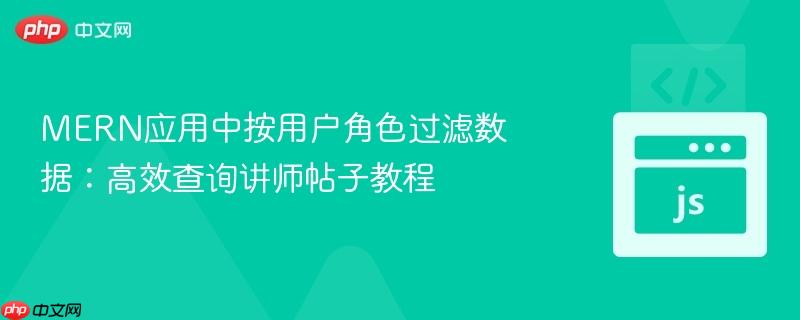
在开始数据查询之前,我们首先需要明确应用程序中的数据模型结构。本教程涉及 post(帖子)和 user(用户)两个核心模型,它们通过 user 字段建立了关联。
1.1 Post 模型
PostSchema 定义了帖子的结构,其中包含标题、内容、标签、浏览量等信息。最关键的是 user 字段,它通过 mongoose.Schema.Types.ObjectId 类型并 ref: 'User',明确指出每个帖子都关联到一个 User 文档。
import mongoose from 'mongoose';
const PostSchema = new mongoose.Schema(
{
title: {
type: String,
required: true,
},
text: {
type: String,
required: true,
unique: true,
},
tags: {
type: Array,
default: [],
},
viewsCount: {
type: Number,
default: 0,
},
user: { // 关键:关联到 User 模型
type: mongoose.Schema.Types.ObjectId,
ref: 'User',
required: true,
},
imageUrl: String,
comments: [{ type: mongoose.Schema.Types.ObjectId, ref: 'Comment' }],
},
{
timestamps: true,
},
);
export default mongoose.model('Post', PostSchema);1.2 User 模型
UserSchema 定义了用户的结构,包括全名、邮箱、密码哈希等。其中,role 字段是本教程的核心,它是一个枚举类型,限定了用户角色只能是 "student"(学生)或 "instructor"(讲师)。
import mongoose from "mongoose";
const UserSchema = new mongoose.Schema({
fullName: {
type: String,
required:true,
},
email: {
type: String,
required:true,
unique: true,
},
passwordHash: {
type: String,
required: true,
},
role: { // 关键:定义用户角色
type: String,
enum: ["student", "instructor"],
required: true,
},
avatarUrl: String,
},
{
timestamps: true,
});
// 辅助方法,用于判断用户角色
UserSchema.methods.isStudent = function () {
return this.role == "student";
};
UserSchema.methods.isInstructor = function () { // 修正拼写错误
return this.role == "instructor";
};
export default mongoose.model('User', UserSchema);开发者在尝试根据用户角色筛选帖子时,常会遇到一个误区:直接在 PostModel 上查询 role 字段。例如:
// 错误示例:无法直接在 Post 模型上查询 User 的 role 字段
export const getAllByTeacher = async(req, res) => {
try {
const posts = await PostModel.find({role: "instructor"}).populate('user').exec(); // 错误!Post 模型没有 role 字段
res.json(posts);
} catch (e) {
console.log(e);
res.status(500).json({
message: 'Can not get post'
});
}
}这种方法之所以错误,是因为 role 字段是 User 模型的一部分,而不是 Post 模型的一部分。Post 模型只存储了关联用户的 _id,并没有直接存储用户的 role 信息。Mongoose 的 populate 方法虽然可以填充关联的用户数据,但它是在查询结果返回后才进行的操作,不能用于主查询的筛选条件。
要正确地获取所有讲师发布的帖子,我们需要采用一个两阶段的查询策略:
第一阶段:识别目标用户 首先,查询 User 模型,找出所有 role 为 "instructor" 的用户,并收集他们的 _id。
第二阶段:筛选相关帖子 然后,使用这些讲师的 _id 作为条件,查询 Post 模型中 user 字段包含在这些 _id 列表中的所有帖子。
下面是具体的实现代码:
import PostModel from '../models/Post.js'; // 假设 PostModel 已经导入
import UserModel from '../models/User.js'; // 假设 UserModel 已经导入
export const getAllByInstructor = async (req, res) => {
try {
// 阶段一:查找所有角色为“instructor”的用户
const instructors = await UserModel.find({ role: "instructor" }, '_id'); // 只查询 _id 字段以优化性能
// 提取所有讲师的 _id 到一个数组
const instructorIds = instructors.map(u => u._id);
// 阶段二:根据讲师的 _id 查找他们发布的帖子
// 使用 $in 操作符来匹配 user 字段在 instructorIds 数组中的所有帖子
const posts = await PostModel.find({ user: { $in: instructorIds } })
.populate('user') // 填充关联的 User 数据
.exec();
res.json(posts);
} catch (err) {
console.error(err); // 使用 console.error 打印错误
res.status(500).json({
message: '无法获取讲师帖子',
error: err.message // 返回更详细的错误信息
});
}
};4.1 阶段一:获取讲师ID
4.2 阶段二:查询帖子
4.3 错误处理
4.4 性能考量
通过本教程,我们学习了如何在MERN应用中,根据用户角色(如“讲师”)高效地查询其发布的帖子。关键在于理解Mongoose中模型关联的原理,并采用两阶段查询法:首先获取目标用户的ID,然后利用这些ID筛选出相关的帖子。这种方法不仅解决了直接查询关联字段的误区,还通过 populate 提供了丰富的数据,并兼顾了代码的可读性和维护性。在实际开发中,务必结合错误处理和性能优化策略,构建健壮的后端服务。
以上就是MERN应用中按用户角色过滤数据:高效查询讲师帖子教程的详细内容,更多请关注php中文网其它相关文章!

每个人都需要一台速度更快、更稳定的 PC。随着时间的推移,垃圾文件、旧注册表数据和不必要的后台进程会占用资源并降低性能。幸运的是,许多工具可以让 Windows 保持平稳运行。




Copyright 2014-2025 https://www.php.cn/ All Rights Reserved | php.cn | 湘ICP备2023035733号